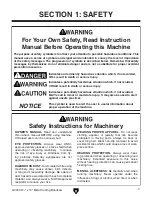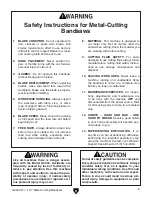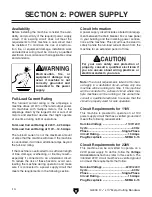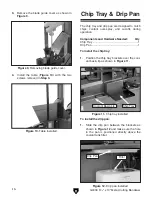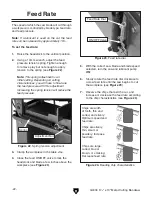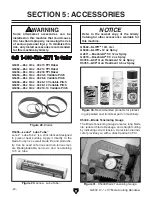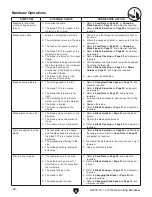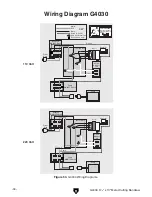
G4030 6
1
⁄
2
" x 10" Metal-Cutting Bandsaw
-21-
While simple in concept and function, many
issues must be taken into account and to find
and use the correct cutting fluid. Always follow all
product warnings and contact the fluid manufac-
turer for unanswered questions.
Use the selections below to choose the appro-
priate cutting fluids:
•
For cutting low alloy, low carbon, and gen-
eral-purpose category metals with a bi-metal
blade —use a water soluble cutting fluid.
•
For cutting stainless steels, high carbon, and
high alloy metals, brass, copper and mild
steels—use "Neat Cutting Oil" (commonly
undiluted mineral oils) that have extreme
pressure additives (EP additives).
•
For cutting cast iron, cutting fluid is not rec-
ommended.
Remember:
Too much flow at the cutting fluid
nozzle will make a mess and can make the work
area unsafe; and not enough fluid at the cut will
heat the blade, causing the blade teeth to load up
and break.
Cutting Fluid
BIOLOGICAL AND
POISON HAZARD! Use
proper personal protection
e q u i p m e n t w h e n
handling cutting fluid
and follow federal, state,
and fluid manufacturer
requirements to properly
dispose of cutting fluid.
Blade Guides
The blade guides should be as close to the
workpiece as possible. This will help ensure
straight cuts by keeping the blade from twisting
and drifting off the cut line.
To adjust the blade guides:
1.
Loosen the knob shown in
Figure 21
and
slide the rear blade guide as close to the
workpiece as possible, then tighten the
knob.
Figure 21.
Blade guides.
Blade Guides
Knob
Summary of Contents for G4030
Page 15: ...G4030 61 2 x 10 Metal Cutting Bandsaw 13 Hardware Recognition Chart...
Page 37: ...G4030 61 2 x 10 Metal Cutting Bandsaw 35 Parts Breakdown G4030...
Page 38: ...36 G4030 61 2 x 10 Metal Cutting Bandsaw Parts Breakdown G4030...
Page 39: ...G4030 61 2 x 10 Metal Cutting Bandsaw 37 Parts Breakdown G4030...
Page 47: ......

